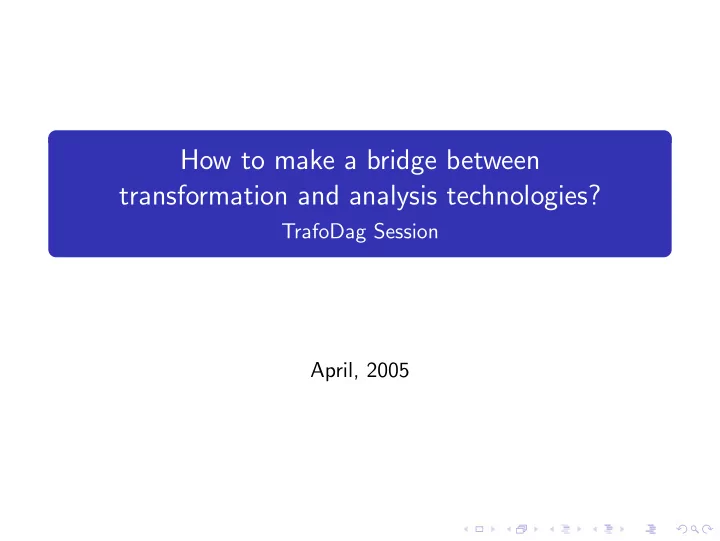

How to make a bridge between transformation and analysis technologies? TrafoDag Session April, 2005
Transformation and Analysis in Software Engineering Transformation Analysis Conversion Abstraction Presentation Source Code Abstractions Documentation Generation Formalization There is a difference between analysis and transformation Technological diversity: Transformation: graph/term rewriting, fp, templates, . . . Analysis: databases, logic, relations, state machines, . . . Exploiting the benefits of understanding a domain How to make a bridge between these kinds of technologies?
Answer 1 You need unique identification of entities Choice: passing source code locations or entities Identify by reference: locations Identify by value: unique id Obtaining unicity can be a non-trivial computation Locations are highly unstable
Answer 2 There is no conceptual problem. Interesting engineering issues, inventoried by example. Integration scheduling Lazy — get data when needed, or transform when needed SOUL, Stratego Eager — serialize and transmit full model TXL/GROK, ASF+SDF/RScript, Columbus Composition: monolithic vs Separated Language design: one general formalism for both separation into different domains conclusion: all existing systems separate the domain
Domain summary The given two soups of technologies View Render Definition Recovery Analysis Synthesis Presentation Abstraction Computation Normalization Optimization Transformation lazy / eager local Locality Bridge global
Domain summary The variability without the constraints Co-routines-RMI Batch-Pipe/Filter 1 way/2 way Protocol Direction left/right Who's the Driver AS {T,G} Granularity Architecture Communication Call graphs By reference Identification By value Data Get/Put Marshalling Linking Sharing Files Representation AS {T, G} Parse trees
Separating versus Unifying Monolithic approach Separated approach Advantages Advantages Consistency is easier Forces explicit contracts No marshalling Reuse, variability by Disadvantages composition Tends to loose domain Disadvantages benefits Marshalling may be Glass boxes, everything complex depends on everything Update consistency problem
Conclusion Identity Identified features and variability Discussed some trade-offs My suggestion for the future: Fill out the variability analysis and formalize in FDL Then express constraints that capture trade-offs (implication, exclusion, dependance)
Recommend
More recommend